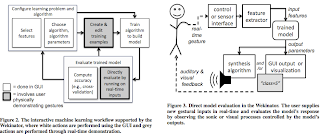Paper Reading #26 : Embodiment in Brain-Computer Interaction

Reference Authors: Kenton O’Hara, Abigail Sellen, Richard Harper Affiliations : Microsoft Research, 7 J J Thomson Avenue Cambridge, UK Presentation: CHI 2011, May 7–12, 2011, Vancouver, BC, Canada Summary Hypothesis The paper highlights the importance of considering the body in BCI and not simply what is going on in the head. They hypothesize that people use bodily actions to facilitate control of brain activity but also to make their actions and intentions visible to, and interpretable by, others playing and watching the game and hence allows those action to be socially organised, understood and coordinated with others and through which social relationships can be played out. Contents The paper discusses findings from a real world study of a BCI-controlled game played as a social activity in the home. This study draws on the philosophical and analytic concerns found in CSCW where techniques for analysing the social in all its embodied forms are well developed. For...









